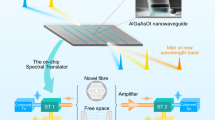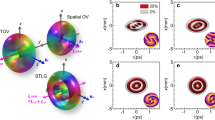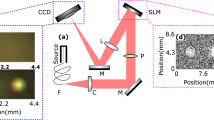Abstract
AT the Abastumani Astrophysical Observatory we have been making continuous observations of the twilight sky for seventeen years, with the view of studying the features of the Earth's atmosphere1. In 1957, we began to study the twilight sky spectra by means of a grating spectrograph (grating 135 × 90 mm.2, 1,200 lines/mm.; camera, f = 70 mm., dispersion 80 A./mm. in the red region). During the year beginning December 1957, 67 spectrograms were obtained in the region 5400–6800 A., of which 29 belong to the morning and 38 to the evening twilight. The well-known lines of oxygen, λλ6300–6364 A. [O I], 5577 A. [O I] and the sodium D-lines 5890–5896 A., are always present on these spectrograms. In addition, some new lines and bands appear permanently or episodically on them. Two such spectrograms are reproduced in Fig. 1. Table 1 contains the wave-lengths of the lines and bands (λobs.), the number of cases of their appearance (n) and the suggested interpretation. This is a preliminary interpretation in so far as in some cases the difference Δλ = λobs. − λ (λ is an accurate value of the line or band wave-length for a given atom or molecule) reaches the value of 4–5 A., which exceeds the probable error of measurement of λobs. (1–2 A.). Some additional systematic errors in the determination of λobs. may have occurred. They may be caused by the high intensity and the complicated structure of the continuous spectrum of the twilight sky, on the background of which one has to study faint lines and bands.
This is a preview of subscription content, access via your institution
Access options
Subscribe to this journal
Receive 51 print issues and online access
$199.00 per year
only $3.90 per issue
Buy this article
- Purchase on SpringerLink
- Instant access to full article PDF
Prices may be subject to local taxes which are calculated during checkout
Similar content being viewed by others
References
Megrelishvili, T. G., and Khvostikov, I. A., Rep. Acad. Sci., U.S.S.R (Doklady), 59, 7 (1948). Megrelishvili, T. G., Bull. Abastumani Astrophys. Obs., 9 (1949); Rep. Acad. Sci., U.S.S.R. (Doklady), 116, 5 (1957).
Le Blanc, F., Tanaka, Y., and Jursa, A., J. Chem. Phys., 28, N 5, 979 (1958).
Delannoy, J., and Weill, G., C.R. Acad. Sci., Paris, 247, 806 (1958).
Barbier, D., Delannoy, J., and Weill, G., C.R. Acad. Sci., Paris, 247, 886 (1958).
Author information
Authors and Affiliations
Rights and permissions
About this article
Cite this article
KHVOSTIKOV, I., MEGRELISHVILI, T. New Bands and Lines in the Twilight Sky Spectrum. Nature 183, 811 (1959). https://doi.org/10.1038/183811a0
Issue date:
DOI: https://doi.org/10.1038/183811a0
This article is cited by
-
Near Infra-Red System of Nitrogen
Nature (1959)



